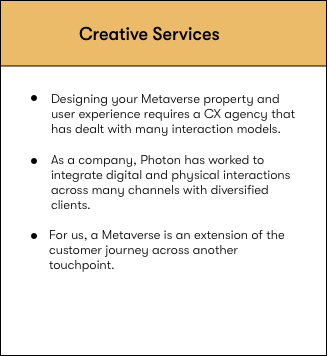Key Performance Indicators (KPIs) are those measurements that most accurately show whether a business is progressing towards a goal. KPIs are necessary, just like setting product strategy and product vision. The right KPIs help you to better understand how customers react to various business strategies and enable you to make informed decisions. Without KPIs, it is not easy to gauge progress over time.
Top eCommerce Metrics and KPIs you should measure
Turn your data into competitive advantage
This article will get you on top of the most up-to-date eCommerce metrics and KPIs. Connect with Photon to accelerate your digital transformation initiatives and remain competitive in the fast-paced digital world.
There are many types of key performance indicators across eCommerce. This article will focus on Sales, Marketing, and Customer Service. We will also discuss the available Web Analytics tools, which facilitate measuring these KPIs through scheduled and ad-hoc reports. Some of the most common eCommerce KPIs and metrics include:
- Average Order Value (AOV)
- Revenue-Per-Visitor (RPV)
- Cart-abandonment-Rate
- Site-traffic
- Page Views
- Click-through-rate
- Customer Satisfaction Score (CSAT)
- Net Promoter Score (NPS)
- Onsite Search Position Clicked
Sales - Key Performance Indicators
Sales KPIs provide data on how the business is doing in terms of conversion and revenue. These metrics can be sliced and diced for a specific channel or for some time to get additional information. Find below the table that captures the key sales KPIs.
Download the blueprint of Sales KPIs here >>
The above list of KPIs is only a few of the key metrics. Factors such as industry, current stage of the business, and overall business goals for the respective stages are critical while considering KPIs for decision making. There should always be one primary metric and three to four supporting metrics that will guide you towards the primary metric. It will help avoid decision paralysis.
For instance, a 1% conversion rate is terrible if your Average Order Value (AOV) is $10, whereas a 1% conversion rate is excellent if your AOV is $800. If the product team is making a decision based on the conversion rate and AOV alone, then it is the equivalent of reading one chapter in a book and proclaiming to have understood the whole plot.
Instead, consider Revenue-Per-Visitor (RPV) along with Conversion Rate (CR) and AOV. It will allow you to determine whether your short-term and long-term goals align with the current stage of the business.
For instance, if the RPV is on the lower side along with supporting AOV and CR, it would suggest that you are aiming for long-term revenue growth. On the other hand, if the RPV is on the higher side, you are focused on driving profitability.
Also, it is crucial to be aware of which KPI can be a primary indicator for functionality or feature. For example, if you want to measure the success of some promotional content, Click-Through-Rate (CTR) can be your primary KPI. Most of the features plugged into Top-of-Funnel (ToFu) / Path-to-Product features on an eCommerce site need to be measured by product view rate.
Marketing: Key Performance Indicators
Marketing KPIs provide how well we are tracking marketing and advertising goals. In addition, these metrics will provide insights on 3Ws & 1H data:
Who is buying? What products are users buying? When are they buying & how are they buying? Also, this KPI has an impact on sales KPIs.
Download the blueprint of Marketing KPIs here >>
It is essential to analyze the marketing KPIs specific to channels as these metrics are very closely related to the respective channels. Also, we should slice and dice these metrics along with various timelines. All retailers adopt a marketing calendar aligning with their operations. So, it is essential to understand how these KPIs impact during those timeframes. These KPIs are drivers to understanding how your marketing team should plan their budget.
Customer Service: Key Performance Indicators
Customer Service KPIs state how satisfied the customer is with the service provided. The service could range from online to offline customer service. These KPIs are going to improve customer retention, thereby improving sales. A recent study by HBR shows that increasing customer retention rates by 5% increases profits by 25% to 95%. Hence a deep understanding of this KPI will help retain your customers.
Download the blueprint of Customer Service KPIs here >>
Above are a few generic KPIs applicable for both the digital and offline (Stores/ Call Centers) world. In addition, there are a few other customer service KPIs useful for call centers, such as First Response Rate, Escalation Rate, and Appeasement Rate. The bottom line is that Customer is the center of the business and keeping them happy should be the goal.
Analytics Reporting Tools
Analytics is the process of exploring data and reports to extract meaningful insights and improve business performance.
Reporting is organizing data into informational summaries to monitor how different areas of a business are performing. There are a lot of COTS products; the popular ones that online retailers use are Adobe Analytics, Google Analytics, and Core metrics. These web analytics products facilitate how the data is collected and analyzed. These data would range from traffic metrics to conversion metrics of the website.
In this article, we will cover details around the implementation of web analytics through Adobe Analytics. Therefore, all Site Catalyst Omniture should refer to Adobe Analytics- the new transformed platform. You will often hear terms when you work with Adobe Analytics: Props, eVars, events, and list variables.
Props: Always refers to traffic variables such as visits, visitors, page views, internal search terms, and user type. These generally count the number of times that specific scope has happened.
eVars: These are conversion variables set on different pages. They are usually used to tie the success event back to the last value that was stored in the eVars. For example, look at how the 'Add to cart value' for the session keeps changing throughout the journey of the session. The value is persisted, and the duration of the persistence can be custom defined based on the scope of the respective eVars.
Events: These are counters always tied to an eVar. For Example, how many times add to cart happened. Also, there could be an association between two events to one eVar, for example, Registration form (a) View (b) Submission.
Lists: These are usually Props. It accepts a delimited list of values. For Example, 1) On a page load capturing the list of marketing campaigns 2) On a product listings page load capturing the list of product titles.
Segments: Segments used inside the reporting dashboard enable to group audiences that could be at the visit, hit, or visitor level.
To summarize, Props are traffic variables, whereas eVars are conversion variables. Events are things that can happen on the site and are tied to conversion variables. Within the Adobe Experience Cloud, you could also see an icon called Analytics. It is the application used to build ad-hoc reports or scheduled reports. There is a workspace section where you can slice and dice the data for any specified period. There are many types of visualization techniques, such as Freeform Table, Cohort Table, Funnel/Fallout, Flow (Entry and Exit analysis), and Graphs. Usually, the Props/eVars are put in one dimension and compared against the Metrics between a specified period across different channels.
Popular metrics for Path-to-Product pages in eCommerce retail websites
We have summarized a few KPIs used to measure the success of the features implemented on Path-to-Product pages/Top-of-Funnel. These pages predominately exist to put the customer to the product details so that they will eventually purchase.
Download metrics for Path-to-Product pages in eCommerce sites here >>
Path-to-Product metrics provide a few of the custom events used to track the effectiveness of the functionalities included in the TOP funnel page. In addition, custom standard KPIs like page views, visits, visitors, Bounce Rate, and Exit Rate are used across specified timelines for specific user segments/channels.
Bottom-line
Ever-changing customer behavior and advancements in digital technologies are blurring the lines between the channels. Therefore, we conclude that the metrics mentioned in this article are not the only KPIs required for the success of your eCommerce performance. However, familiarity with the KPIs and metrics highlighted in this article will help you identify how well you perform the activities. It will also help you fine-tune your business strategies to improve the overall performance of your eCommerce.
If you want to accelerate your digital transformation, click here to connect with our experts today.
About the author
Pasupathy Muthupandy
Senior Product Manager at Photon
![]() LinkedIn
LinkedIn
Pasupathy Muthupandy is a Senior Product Manager at Photon, responsible for developing product vision and strategies. He has rich experience leading digital transformation roadmaps for Fortune 500 companies. In addition, as a digital partner, Pasupathy has closely worked with multiple client engagements focusing on developing digital omnichannel products.









